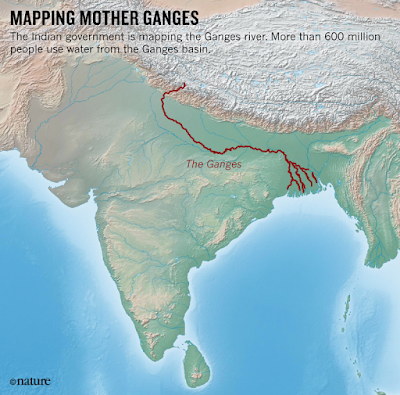Reading Notes: Mahabharata Part A
(I added a picture of the geography of the Ganges river because it is referred to a lot in the Mahabharata. Image can be sourced here)
I read the PDE version of the Mahabharata because that is the most easily accessible for me and worked well with the Ramayana. There is a lot of family webs so I will try to explain them from what I understand from the reading. There was definitely a lot to digest so writing it out in a way I can understand helps me to better know what's going on. I've also attached a family tree from the story I Googled below to refer to. I have bolded new characters when they are introduced.
(I found this image by googling 'Mahabharata family tree'; This image provides a visualization to the complex family dynamics in the Mahabharata that my blog readers can refer to hopefully. Image can be sourced here)
The readers learns that Ganesha scribed the Mahabharata and Vyasa arranged the Vedas; he repeated it to a disciple and it was passed down. King Bharata built the city of Hastinapura. His grandson is King Shantanu of the Ganges and his wife Ganga is the goddess of the Ganges as well. Background on Ganga: she is under a curse where she has to send her offspring in to the Ganges after birth. However, Ganga ensured 1/8th of the power of Vasus to be bestowed to her son who would be able to live among men, just unable to have children or wed. She meets King Shantanu and they get married. She has 8 children, 7 of which are thrown in the river. The 8th one was going to be drowned until the King gets angry and disapproves. She vanishes and comes back the son who is virtuous and noble later named Devavrata (he is a man with god-like powers because his father was man and mother goddess). King Shantanu then wants to marry a young bride when he gets older and sets his eyes on Satyavati, later the mother of Vyasa. The fisherman (?) refused to marry her until he promised her son would be heir. Shantanu didn't want to take away Devavrata's throne, so let her be.
King Shantanu is sad and tells Devavrata why, at which Devavrata takes it upon himself to speak to the fisherman. He tells the fisherman he will give up his throne if his father can marry Satyavati and even let her sons have the kingdom. Devavrata soon is then known as Bhishma. Shantanu and Satyavati have two sons and after Shantanu dies, Bhishma takes care of her and the two sons. The son's names are Chitrangada and Vichitravirya. Bishma wants to find his Vichitravirya a wife. He finds the three daughters of King Kashi and thinks they will be perfect; Bhishma battles in royal combat for the three to bring them back with him. One of the girls, Amba, resents Bhisma and self-immolates to achieve rebirth in a new man's body and become a warrior. His brother Vichitravirya marries two of the sisters.
Vichitravirya dies before his wives gives birth so Satyavati finds a replacement to bear the children. This also makes Bhishma the grandfather/father figure. She ends up calling her son Vyasa to bear two children: Dhritarashtra (blind) and Pandu. Vyasa also has a son with a handmaiden named Vidura. Pandu becomes the heir for the throne and marries Kunti and Madri. I was a bit confused on this part, but I think Kunti gets pregnant through a dream with the divine Surga's child Karna but she sends it in a basket on the river out of embarrassment. A couple wanting a child take the son from the basket and raise him.
Kunti is the mother to Yudhishthira, Bhima, and Arjuna. Madri is the mother to twins named Nakula and Sahadeva. These 5 are the Pandeva brothers.
Pandu, one of Vichitravirya's sons shot at a two-headed deer with a bow and arrow. Little did he know that this deer was capable of magic and cursed Pandu with celibacy Pandu ends up dying because of the curse and his wife dies in his honor. Dhritarashta takes the throne, with Bhishma helping him. Dhritarashta and his wife Gandhari (who wears a blind fold because her husband can not see) have 100 sons and the eldest is Duryodhana. Many advise them to kill Duryodhana (he is supposed to be evil) but the king and his wife do not. The 100 sons are known as the Kauravas.This seems like a self-fulfilling prophecy. If there were many people who thought I should be killed off and I was not, I would probably be bitter and selfish as well. Childbirth, or lackthere-of, seems to be a common interest in ancient Indian literature.
Kunti, the other wife of Pandu, is a widow with 5 sons. The role of a single-mother is difficult so she takes them to be raised with their 100 cousins. It seems like Duryodhana gets jealous when his cousins are getting more out of their teaching with the guru Drona (somehow these 5 cousins are more of a burden than his 99 other siblings).
To add to the family drama, the boys must show of their skills learned under Drona. Arjuna is Pandu's third eldest son and the strongest. He also meets Karna who is his half-brother, which he does not know.
Drona asks for the boys to pay him for his teachings by killing his former childhood friend who is now is enemy King Drupada. Duryodhana gets more jealous as his cousins are more successful than he and his numerous brothers, so now Duryodhana wants to kill Pandu's sons and Kunti.
BIBLIOGRAPHY:
Title: All of part A of the Public Domain Version of Mahabharata which can be sourced here
Authors: Arnold, Besant, Devee, Dutt, Ganguli, Kincaid, Macfie, Mackenzie, Nivedita, Seeger, and Tagore.
|




Hey Maya. Whoa, for a second I thought you created that family tree. I was thinking that was so impressive. One thing about the Mahabharata that I did not have a problem with as much within the Ramayana was ancestry. I was confused within the Mahabharata, when reading about who was related to who and how. This family tree definitely helps clear some misconceptions I had and it is a very useful tool to have. Thanks for sharing that!
ReplyDelete